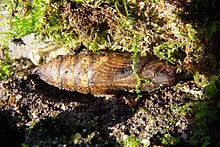Medium wine lover
| Medium wine lover | ||||||||||||
|---|---|---|---|---|---|---|---|---|---|---|---|---|

Middle wine hawk ( Deilephila elpenor ) |
||||||||||||
| Systematics | ||||||||||||
|
||||||||||||
| Scientific name | ||||||||||||
| Deilephila elpenor | ||||||||||||
| ( Linnaeus , 1758) |
The Middle Weinschwärmer ( Deilephila elpenor ) is a butterfly ( moth ) from the family of moth (Sphingidae).
features
The moths reach a wingspan of 45 to 60 millimeters. They have olive-green forewings, in which the wing leading edge is colored thinly pink and on which three pink to pale violet, slightly oblique bands can be seen. The first is only about halfway up the wing. A very small, point-like, white discoidal spot borders on them. The second, near the outer edge of the wing, and the third directly on this edge, both end in the wing tip. The hind wings are pink and have a black band (basal band) at the base. The body is colored olive green and pink, with a longitudinal line also colored pink running along the middle of the abdomen and the heavily haired thorax alternating in the two basic colors. The antennae , legs and partly the inner edge of the forewing are colored white.
The caterpillars are about 80 millimeters long. In the younger stages the caterpillars are green, in later stages they change their color to brown until they are brown-black shortly before pupation . In the event of danger, the small, rather inconspicuous head is pulled together with the thorax segments into the first and second abdomen segments. These are thickened and have two clearly protruding eye spots on each side , which make the animal appear threatening ( mimicry ). In contrast to the very similar caterpillars of the little wine hawk, these are black on one side and light-colored on the other. The anal horn , which sits on the end of the abdomen, is also longer and tapered, instead of just hinted at like a bump.
When alarmed, the caterpillar mimics the movements of a snake by turning its front part with the eye-spots to the left and right.
- Middle hawk caterpillar
Caterpillar on a fuchsia plant
Similar species
- Little Wine Hawk ( Deilephila porcellus )
Synonyms
- Sphinx elpenor Linnaeus, 1758 Syst. Nat. (Edn 10) 1: 491
- Chaerocampa lewisii Butler, 1875 Proc. zool. Soc. Lond. 1875: 247
- Sphinx porcus Retzius, 1783 Genera et Species Insect. : 34
- Pergesa szechuana Chu & Wang 1980
Occurrence
The animals occur all over Europe with the exception of the far north and in Asia , east to Japan . In Central Europe it is the most common type of hawkmoth. You live in humid areas, such as B. in riparian forests , or on bodies of water, but also in parks and gardens.
Way of life
The nocturnal moths fly to flowers to suckle nectar.
Flight and caterpillar times
The moths fly in one generation from mid-May to July, the caterpillars are found from mid-June to August. In hot years or in the south, an incomplete second generation can appear in August and September.
Food of the caterpillars
The caterpillars feed mainly on fireweed such as B. Narrow-leaved willowherb ( Epilobium angustifolium ), also on various jumping herbs, now and then on fuchsias ( Fuchsia ), common purple loosestrife ( Lythrum salicaria ) and common evening primrose ( Oenothera biennis ).
development
The females lay their pale eggs individually or in small groups on the underside of the leaves of the forage plants. During the day, the hatching caterpillars hide and only eat at night. But adult caterpillars also eat during the day. They pupate on the ground in a loose web between parts of the plant. In contrast to other swarmers' dolls , the pupae are heavily grained and also toothed between the segments. The moths hatch after overwintering.
swell
Individual evidence
- ↑ a b c A. R. Pittaway: The Hawkmoths of the western Palaearctic. Harley Books 1993, ISBN 0-946589-21-6
- ^ Deilephila elpenor (Linnaeus 1758). Fauna Europaea, Version 1.3, April 19, 2007 , accessed on January 3, 2008 .
- ↑ Hans-Josef Weidemann, Jochen Köhler: Moths. Weirdos and hawkers. Naturbuch-Verlag, Augsburg 1996, ISBN 3-89440-128-1 , p. 40ff.
- ↑ a b c Heiko Bellmann : The new Kosmos butterfly guide. Butterflies, caterpillars and forage plants. Franckh-Kosmos, Stuttgart 2003, ISBN 3-440-09330-1 , p. 106.
- ↑ Manfred Koch : We identify butterflies. Volume 2: Bears, Spinners, Swarmers and Drills in Germany. 2nd, expanded edition. Neumann, Radebeul / Berlin 1964, DNB 452481929 , p. 110f.
literature
- Günter Ebert (Ed.): The Butterflies of Baden-Württemberg Volume 4, Moths II (Bombycidae, Endromidae, Lemoniidae, Saturniidae, Sphingidae, Drepanidae, Notodontidae, Dilobidae, Lymantriidae, Ctenuchidae, Nolidae). Ulmer Verlag Stuttgart 1994. ISBN 3-8001-3474-8
- David J. Carter, Brian Hargreaves: Caterpillars and Butterflies of Europe and their Forage Plants. Blackwell Wissenschaftsverlag 1987, ISBN 3-8263-8139-4






